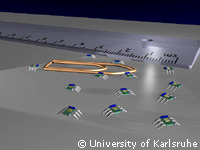EU funded project creates a swarm of intelligent artificial ants
The I-SWARM project aims to develop the technological advances that will lead to the mass-production of microrobots, which can then be employed as a 'real' swarm consisting of up to 1,000 robot clients. By combining experts in the fields of micro robotics and distributed multi-agent systems, the project aims to take a leap forward in robotics research. Robots working together is not a new idea, but so far only groups of 10 to 20 centimetre-sized robots have been used to mimic certain aspects of social insects, and are very limited in terms of perception, manipulation and co-operation capabilities. Innovative aspects of I-SWARM include a reduction in the size of the robots (millimetre-sized), together with an increase in both the number of cooperative elements (up to 1,000) and the extent of their collective behaviour. I-SWARM, which stands for 'Intelligent small world autonomous robots for micro-manipulation', is a four-year project supported by 4.40 million euro under the European Commission's Future and Emerging Technologies (FET) programme, under the Sixth Framework Programme (FP6). The project involves a consortium of ten European research centres from seven EU countries plus Switzerland, and is coordinated by the Micromechatronics and Microrobotics Group of the Institute for Process Control and Robotics (IPR), University of Karlsruhe, Germany. The I-Swarm project draws on computer chip manufacturing to facilitate the mass-production of millimetre-sized robots, employed in a 'real' swarm consisting of up to 1,000 robots. Each robot will be equipped with limited, pre-rational on-board intelligence, so that the swarm will consist of a huge number of heterogeneous robots with different ranges of sensors, manipulators and computational power. To date, the I-Swarm team have built two groups of centimetre-sized robots, named Jasmine and Micron, in order to test swarm communication. Group communication is based on infrared signals, similar to that in a remote control device. When one robot detects an object, it passes the message to a nearby robot, which in turn signals to others, creating a communication chain signalling that they've located an obstacle. They then begin to circle it. Such robot swarms are expected, one day, to be deployed by the thousand to perform a variety of applications, including the inspection of pipelines, bridges and engines, carrying out micro assembly and even undertaking tasks such as diagnostics and medical procedures inside the human body.



